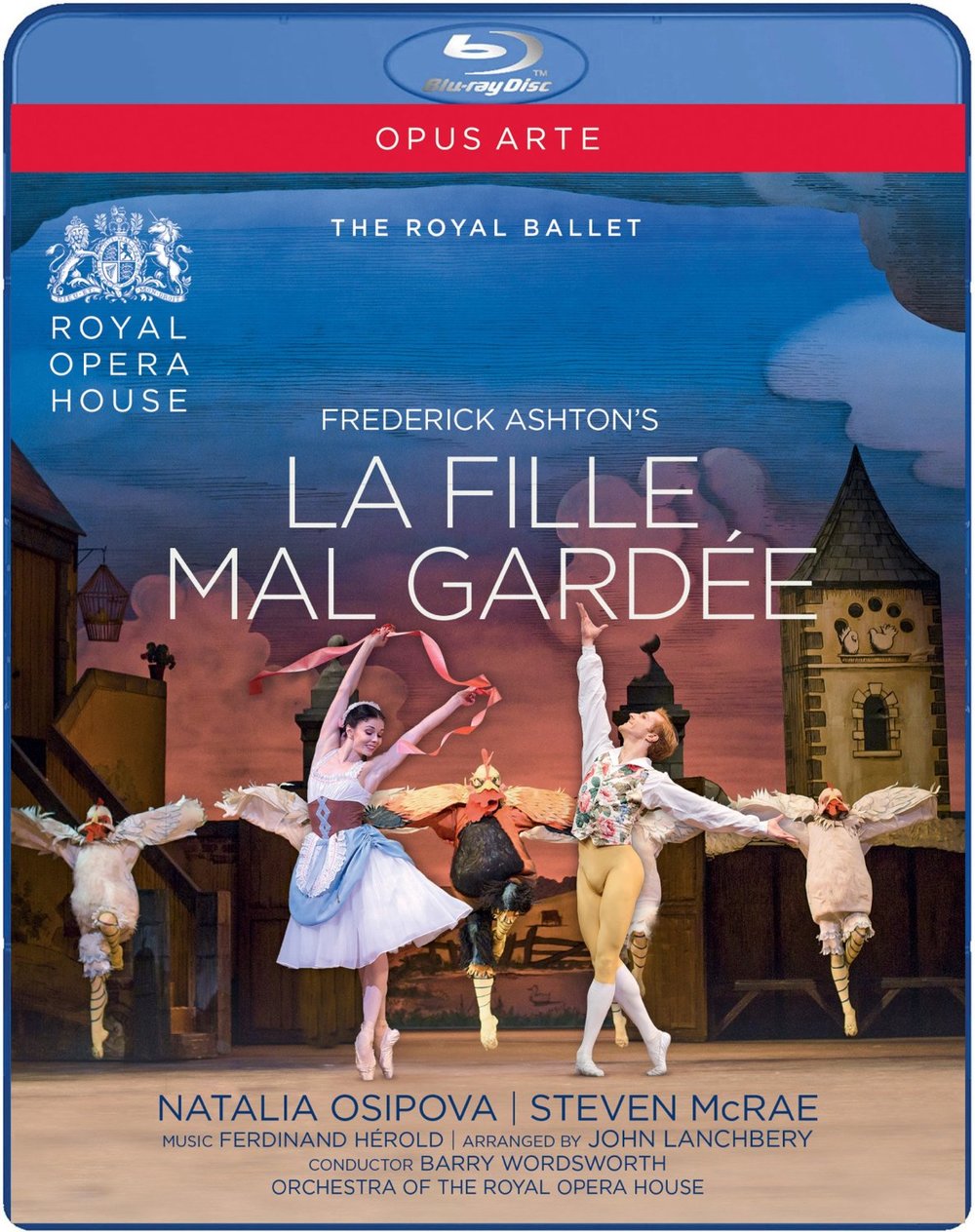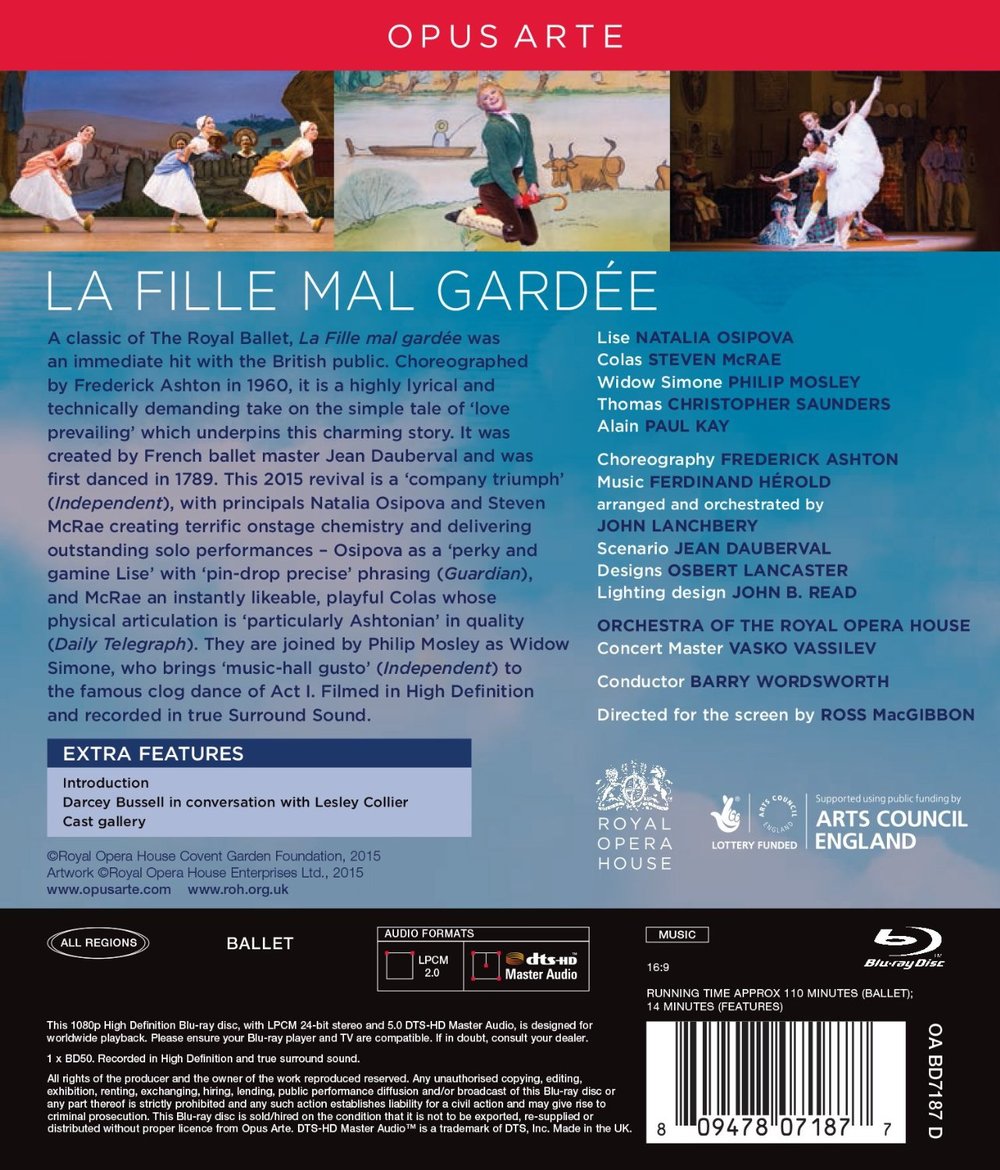

La fille mal gardée ballet with choreography by Frederick Ashton. Music originally composed by Ferdinand Hérold and arranged by John Lanchbery. Staged 2015 at the Royal Opera House. Stars Natalia Osipova (Lise), Steven McRae (Colas), Philip Mosley (Widow Simone), Christopher Saunders (Thomas), and Paul Kay (Alain). The Cockerel is danced by Michael Stojko; the Hens are Francesca Hayward, Meaghan Grace Hinkis, Gemma Pitchley-Gale, and Leticia Stock; Lisa's Friends are Christina Arestis, Claire Calvert, Olivia Cowley, Fumi Kaneko, Emma Maguire, Kristen McNally, Sian Murphy, and Beatriz Stix-Brunell; the Notary is Gary Avis, and the Notary's Clerk is Michael Stojko; other minor roles are danced by artists and students at the Royal Ballet. Barry Wordsworth conducts the Orchestra of the Royal Opera House (Concert Master Vasko Vassilev). Scenario by Jean Dauberval; designs by Osbert Lancaster; lighting by John B. Read. Directed for TV by Ross MacGibbon. Released 2015, disc has 5.1 dts-HD Master Audio sound. Grade: A-
This title is, of course, an update of the terrific production of La fille mal gardée with Marianela Nuñez and Carlos Acosta performed 2005 and published 2009 (the "old version"). 10 years past after the old version was danced, and The Royal Ballet decided to issue a "new version" danced in 2015 with an all-new cast. To learn more about the story line of this ballet, see my report on the the old version linked above. In my story below, I focus on the differences between the two versions.
At the outset, I note that the sets and costumes for the two versions appear to be the same. But there is considerable difference in the lighting. In the old version, the light is high and bright (except in the storm scene). In the new version, lighting is much reduced to create a more atmospheric look. When needed, local lighting or moving spotlights are used. For an example, compare the 1st screenshot below with the 1st screenshot in the report on the old version. This is not to say that the new version is too dark or morose. To the contrary, the new version appears to be more sophisticated than the old, and there is enough light to make each scene seem plausible and pleasant in my home theater:
Sound recording specifications for the two versions are similar. But the SQ in the new version is somewhat better than in the old, where bass sounds were sometimes distorted or muddy. The video in the new version was shot 10 years after the old version, and there is a sight improvement in video resolution and PQ, which I especially note in the storm scene. In the next screenshot you see nice picture resolution in a shot of the whole corps with only moderately bright light:
Here from the new version is a view of Osipova as Lisa and McRae as Colas. Both of them are more photogenic and also slightly more polished dancers than their counterparts, Nuñez and Acosta, in the old version. However, Osipova doesn't have the fantastic acting skills possessed by Nuñez. And McRae can't match the depth and warmth of Acosta's 1000-watt smile and constant display of heart:
The biggest weakness in the cast of new version is Philip Mosley as Widow Simone, Lisa's bossy mom. Just in case you don't know, Ashton calls for Widow Simone to be danced by a man. Years ago when I first watched this ballet in the old version with William Tuckett cast as Simone, it wasn't until I was in my third viewing of the ballet that I finally caught on to this. Tuckett had the right appearance and acting skills to simultaneously impersonate a woman and be hilariously funny. Poor Mosley does his best and has mastered all the moves, but he's too masculine to pull it off:
Next below we see, from the new version, Christopher Saunders as Thomas, the rich farmer, and Paul Kay, Thomas' half-wit sissy son, Alain. Saunders looks appropriately goofy here, but his counterpart in the old version, David Drew, looked even goofier. Paul Kay is good at comedy (see him in "Elite Syncopations" (MacMillian Triple Bill), but he's built too sturdy and handsome to hack it as the desperately pathetic Alain. Jonathan Howells was perfect for this role in the old version:
I mentioned earlier that Osipova and McRae are exceptionally polished dancers. The longest and most elevated scene in this ballet is known as "The Fanny Elssler pas de deux"[Chapter 17]. I didn't fully appreciate the beauty of this pas de deux until I saw it performed by Osipova and McRae, and here are 5 screenshots to show you what I'm talking about:
But the scene I remember the best from La fille mal gardée is the Clog Dance. Below, Mosley tries hard and makes all the moves correctly, but I wind up feeling sorry for him. The Tuckett Clog Dance from the old version is the one I'll always remember:
Osipova is charming in her "When I am married" scene, but Nuñez is incandescent in the old version:
But when Osipova and McRae start dancing together again, there's more magic in the final Pas de deux and Finale:
We have to remember that La fille mal gardée is the most important comic ballet that we have. So I still prefer the old version with its flawless cast of dancers who are perfect for their roles and have the acting ability to make us laugh while doing all that beautiful dancing. I also think that the personal directing of the dancers is better in the old version than in the new. If you can only buy one version, stick with the old, especially if you plan to show this to children or other new-comers to ballet. But if the technical improvements in the new version together with the exceptionally polished dancing by Osipova and McRae appeal to you, I suggest you buy both versions!
I'm keeping my A+ grade for the old show and I'm giving the new show an A-.
OR

















